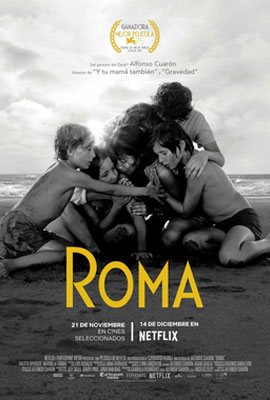
(2018)
directed by Alfonso Cuaron
“Roma” opens with a close-up of water flowing over paving stones. Someone is cleaning a driveway. The beautiful images of cascading water suggest the natural ebb and flow of life. We see the sky reflected in the water. In the reflection, we see an airplane flying far overhead. The airplane suggests an outside world that is distant and isolating. Images of airplanes flying overhead occur throughout the movie, including in the film’s final images. The airplanes flying overhead remind me of the passing trains in Ozu’s film “Tokyo Story” which I discussed earlier in this chapter.
We learn that the driveway is being cleaned by Cleo (Yalitza Aparicio). Cleo is a young indigenous woman who works as a housekeeper and nanny in Mexico City for a wealthy doctor, his wife Sofia, her mother Teresa, and their four young children. Cleo lives in a room above the garage with Adela, the family’s cook. The women are from the same village in the southern state of Oaxaca.
The director, Alfonso Cuaron, has said that “Roma” is a tribute to the women in his life and “the elements that forged me.” The film is dedicated to Liboria Rodriguez, known as “Libo” in Cuaron’s childhood. Libo is the nanny who raised him. Cleo is a fictionalized version of Libo. The children are lively and the house is full of life from morning to night. Every night, when Cleo puts the children to bed, they don’t say, “Goodnight.” They say, “I love you.” The children accept Cleo as a member of the family.
We first meet the father as he struggles to fit the family’s Ford Galaxie into a narrow garage. We can barely see the father. Close-ups of two hands on the steering wheel suggest that his presence in the family is tenuous. When a child hears the parents arguing, Cleo is blamed for not keeping the doors closed. The father is about to go on a business trip and it appears that Sofia is worried about whether he will return. The family is clearly falling apart.
“Roma” is a story of female strength and endurance. After her husband leaves, Sofia confides in Cleo, “No matter what they tell you, we women are always alone.” Cleo learns this lesson after a single date with Fermin, a self-centered martial arts enthusiast. Several weeks after spending the night with Fermin, Cleo learns she is pregnant. Sofia’s somewhat surprising reaction is to support and protect Cleo, perhaps because her own marriage is crumbling. The solidarity between the two women is deeply moving.
Teresa, the grandmother, accompanies the pregnant Cleo to visit the doctor. Along the way, they witness a student demonstration that turns into a deadly riot. This scene is based on a real life incident known as the Corpus Christi Massacre of 1971. A large number of students are killed. Cleo and Teresa witness a scene of a woman crying for help while cradling a dying man. In the context of Cleo’s pregnancy, these scenes are emotionally overwhelming.
Cuaron served as the cinematographer for “Roma.” He shot the film in large format digital black and white creating images that have extraordinary clarity and depth. He has transformed the spirit of Italian neorealism. Throughout the film, Cuaron speaks with images. Cuaron positions his camera in the center of a room, for example, and lets it slowly rotate, following Cleo as she moves about cleaning house. We see what Cleo sees and we also see Cleo as she works. Towards the end of the movie, the camera moves side by side with Cleo as she wades into violently crashing waves to save one of the children from drowning. This stunning sequence is absolutely riveting. The camera seems to embody Cleo and her loving presence in the family.
“Roma” is a cinematic masterpiece of breathtaking beauty. Seldom has a family’s story been presented on screen with such empathy and realism. “Roma” expands our definition of family and reminds us of the love and unbreakable bonds between family members.